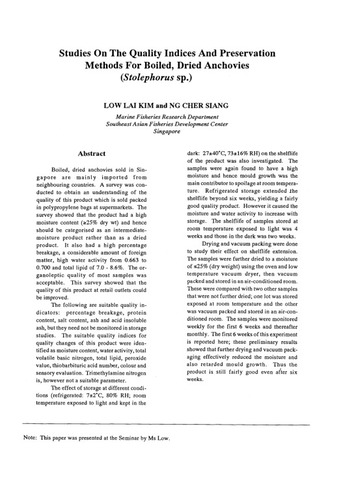| dc.contributor.author | Low, Lai Kim | |
| dc.contributor.author | Ng, Cher Siang | |
| dc.contributor.editor | Hooi, Kok Kuang | |
| dc.contributor.editor | Miwa, Katsutoshi | |
| dc.contributor.editor | Salim, Mohamed Bin | |
| dc.date.accessioned | 2019-04-25T10:28:46Z | |
| dc.date.available | 2019-04-25T10:28:46Z | |
| dc.date.issued | 1991 | |
| dc.identifier.citation | Low, L. K., & Ng, C. S. (1991). Studies on the quality indices and preservation methods for boiled, dried anchovies (Stolephorus sp.). In K. K. Hooi, K. Miwa, & M. B. Salim (Eds.), Proceedings of the Seminar on Advances in Fishery Post-Harvest Technology in Southeast Asia: Singapore, 6-11 May, 1991 (pp. 258-272). Singapore: Marine Fisheries Research Department, Southeast Asian Fisheries Development Center. | en |
| dc.identifier.isbn | 9971882914 | |
| dc.identifier.uri | http://hdl.handle.net/20.500.12066/4800 | |
| dc.description.abstract | Boiled, dried anchovies sold in Singapore are mainly imported from neighbouring countries. A survey was conducted to obtain an understanding of the quality of this product which is sold packed in polypropylene bags at supermarkets. The survey showed that the product had a high moisture content (=25% dry wt) and hence should be categorised as an intermediate-moisture product rather than as a dried product. It also had a high percentage breakage, a considerable amount of foreign matter, high water activity from 0.663 to 0.700 and total lipid of 7.0 - 8.6%. The organoleptic quality of most samples was acceptable. This survey showed that the quality of this product at retail outlets could be improved.
The following are suitable quality indicators: percentage breakage, protein content, salt content, ash and acid insoluble ash, but they need not be monitored in storage studies. The suitable quality indices for quality changes of this product were identified as moisture content, water activity, total volatile basic nitrogen, total lipid, peroxide value, thiobarbituric acid number, colour and sensory evaluation. Trimethylamine nitrogen is, however not a suitable parameter.
The effect of storage at different conditions (refrigerated: 7±2 C, 80% RH; room temperature exposed to light and kept in the dark: 27±40°C, 73±16% RH) on the shelflife of the product was also investigated. The samples were again found to have a high moisture and hence mould growth was the main contributor to spoilage at room temperature. Refrigerated storage extended the shelflife beyond six weeks, yielding a fairly good quality product. However it caused the moisture and water activity to increase with storage. The shelflife of samples stored at room temperature exposed to light was 4 weeks and those in the dark was two weeks.
Drying and vacuum packing were done to study their effect on shelflife extension. The samples were further dried to a moisture of =25% (dry weight) using the oven and low temperature vacuum dryer, then vacuum packed and stored in an air-conditioned room. These were compared with two other samples that were not further dried; one lot was stored exposed at room temperature and the other was vacuum packed and stored in an air-conditioned room. The samples were monitored weekly for the first 6 weeks and thereafter monthly. The first 6 weeks of this experiment is reported here; these preliminary results showed that further drying and vacuum packaging effectively reduced the moisture and also retarded mould growth. Thus the product is still fairly good even after six weeks. | en |
| dc.language.iso | en | en |
| dc.publisher | Marine Fisheries Research Department, Southeast Asian Fisheries Development Center | en |
| dc.title | Studies on the quality indices and preservation methods for boiled, dried anchovies (Stolephorus sp.) | en |
| dc.type | Conference paper | en |
| dc.citation.spage | 258 | |
| dc.citation.epage | 272 | |
| dc.citation.conferenceTitle | Proceedings of the Seminar on Advances in Fishery Post-Harvest Technology in Southeast Asia: Singapore, 6-11 May, 1991 | en |

